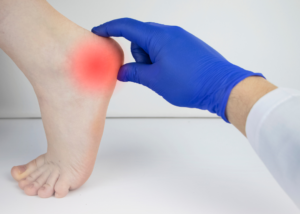As a manager, CEO or small business owner, you know that it’s important to support your employees in maintaining their health and wellbeing. While many attribute these benefits to helping reduce sick days which would otherwise cause lost productivity and revenue, the real impact of having sick or otherwise unwell employees is much more complex – and it is having an exponential effect on Melbourne businesses.
As our Sole Motion team is trusted as the go-to health providers by a range of businesses across the city, today we’re sharing about two key factors impacting these companies: health-related presenteeism and its impact on productivity and performance, and regular exercise and its ability to support the physical and mental wellbeing of your team to improve performance, communication, your work environment, and much more. Through it all, our team is here to support you and your employees health and well-being.
Presenteeism: The Real Impact That Poor Health Has On Melbourne Businesses
While absenteeism is an easy tick-box to complete, presenteeism and its impact is much harder to identify within a business. Presenteeism is the problem of having staff on the job but not functioning at their full capacity, often due to an illness, injury or other medical condition. Presenteeism has been shown to cut productivity by one-third or more – because when people don’t feel great, they don’t perform at their best.
Unfortunately, the number of employees coming into work while sick has more than tripled since 2010. Major contributing factors to presenteeism include:
- Headaches and migraines
- Back pain and arthritis
- Depression and high stress
- Muscle-skeletal conditions
- Lack of physical activity
- Obesity
- Sleeping difficulties, and more
The result we often see from health-related presenteeism is that despite wanting to work at a normal and expected pace, employees are limited by their situation, either physically or mentally. They may take longer to complete tasks than usual, may need to repeat tasks that haven’t been completed well, and are more likely to make errors or produce work that isn’t as good as it could be otherwise. The result is that the cost of presenteeism outweighs the cost of absenteeism:
- Harvard Business Review has estimated that presenteeism costs the U.S. economy more than US$150 billion a year in lost productivity, far surpassing absenteeism costs.
- A UK survey found that 79% of construction workers reported presenteeism related to musculoskeletal injury in the last year. Another study estimated approximately 75% of workplace presenteeism was related to musculoskeletal pain.
- A 2018 study in Japan found that the monetary value due to absenteeism was $520 per person per year and that of presenteeism was $3,055. Two of the highest total cost burdens were related to musculoskeletal disorders, as well as mental (behavioural) health conditions.
- Here in Australia, presenteeism is costing our economy 34 billion dollars each year, and is noted to reduce work team cohesion, increase the likelihood of accidents, increase job turnover, worsen health outcomes, and lead to a longer overall recovery time.
With the very real consequences on both businesses and their valued employees, this is where our practitioners are adding great value by providing early and timely management of a range of musculoskeletal conditions, disorders, health problems and challenging circumstances. Our practitioners assess, diagnose and provide effective treatment plans early, and as such, are often able to offer care for conditions while they are in their early tender stages – before they progress to crippling pain that makes movement difficult. The result is better health outcomes, reduced recovery times, employees feeling supported and in control, and businesses having employees that can be present on the job.
Regular Exercise: Supporting Your Team To Succeed
While supporting your employee’s recovery and journey back to optimum health, our practitioners also support them to continue to stay active and be able to enjoy the physical activities they love without pain. While it’s easy to talk about the physical benefits of engaging in regular exercise, especially in a hands-on role like if you’re a tradie, the benefits beyond the physical apply across every industry and include:
- Brightening mood: 20 minutes of moderate-intensity exercise provides mood-boosting benefits that last up to 12 hours. These benefits range from improved self-esteem and confidence, to better sleep and vitality. At work, feeling good helps us stay engaged and productive. We are more satisfied with our work, which is linked to greater feelings of security, support, respect and being valued. We’re also more tolerant and resilient, and have an extra buffer against stressful challenges that helps us bounce back from setbacks.
- Improving focus and memory: As we move, our blood, glucose and oxygen levels are kept at optimum levels while inflammation is reduced and growth factors are produced to assist with our brain health. This better enables us to concentrate, improves our memory consolidation, and promotes our learning. At work, when we have the right mindset to focus, we get more done. A self-reported study showed that on the days that employees exercised, they experienced a 72% improvement in work completed and in their time management.
- Boosting creativity: Exercise as simple as walking improved creativity in 81% to 100% of participants in a study, who were almost twice as likely to produce novel and high-quality thoughts compared to their counterparts who didn’t exercise.
- Promoting pro-social behaviour: Both group and solo exercise produces an increase in prosocial behaviour, including improving trust and cooperation. Group settings also help to develop a social identity, a sense of belonging, and creates meaningful connections.
- Reducing stress, anxiety and the risk of major depression: Seven out of ten adults experience stress or anxiety daily, diminishing their focus, productivity and ability to make rational decisions. Caring for our physical health through exercise reduces stress hormone levels, relaxes our muscles, and stimulates the production of endorphins that boost our mood and manage our pain. At work, this helps improve our performance while reducing productive hours lost due to absenteeism and presenteeism. Exercise also lowers the risk of experiencing the serious physical effects of chronic stress including high blood pressure, heart disease, diabetes, fatigue, trouble sleeping and more. Replacing 15 minutes of sitting with 15 minutes of running, or one hour of sitting with one hour of walking also reduces the risk of major depression by 26%.
- Improves energy: Exercise works at both the cellular level to help the body create energy, as well as improving the circulation of oxygen and nutrients to the cells and releasing of hormones during exercise. At work, alongside helping you stay focused on your tasks for longer, research suggests those with good levels of energy are more likely to voluntarily stay at their job, and less likely to be let go.
Partner With Sole Motion For Better Health
Our team is proud to be working alongside fantastic, thriving businesses whose employees experience health benefits that aren’t just limited to themselves or their workplaces – but to their personal lives and families too. We offer a range of occupational and musculoskeletal health services ranging from workplace ergonomics to annual safety boot assessments and much more.
To talk to our team about how we can best work together to support your employees, contact Justin via email at justin@solemotion.com.au





